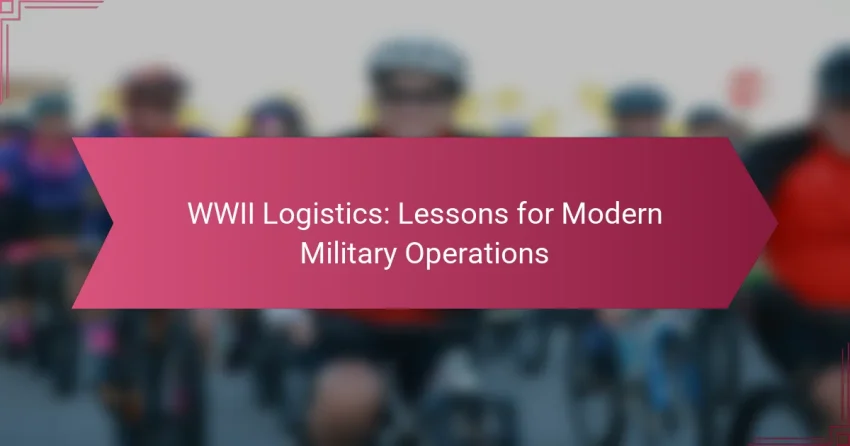World War II logistics played a pivotal role in shaping military operations by highlighting the importance of effective supply chain management, transportation coordination, and strategic planning. The challenges faced during this period, such as supply shortages and difficult terrain, necessitated innovative solutions that continue to inform modern military strategies. By understanding these historical lessons, contemporary forces can enhance their operational efficiency and adaptability in today’s complex environments.

What Are the Key Logistics Strategies from WWII?
The key logistics strategies from WWII include effective supply chain management, transportation coordination, resource allocation, strategic planning, and robust communication systems. These strategies were crucial for ensuring that military operations were well-supported and executed efficiently across various theaters of war.
Supply Chain Management
Supply chain management during WWII involved coordinating the flow of materials, equipment, and personnel to meet the demands of military operations. This required meticulous planning and the ability to adapt to changing circumstances, such as enemy actions or supply shortages.
One effective approach was the use of centralized depots to store critical supplies, which allowed for rapid distribution to front-line units. Military planners learned the importance of maintaining buffer stocks to prevent disruptions in supply chains, especially in remote or hostile areas.
Transportation Coordination
Transportation coordination was vital for moving troops and supplies efficiently. Different modes of transport, including trucks, trains, and ships, were utilized to optimize logistics based on terrain and urgency. Effective scheduling and routing were essential to minimize delays.
For instance, the Allies employed a system of priority shipments to ensure that critical supplies reached the front lines first. This approach highlighted the need for flexibility in transportation plans to respond to battlefield dynamics.
Resource Allocation
Resource allocation focused on distributing limited resources effectively among various military units. Decision-makers had to assess the needs of different operations and prioritize allocations based on strategic objectives.
One lesson learned was the importance of using data to inform resource distribution. By analyzing consumption rates and operational requirements, military planners could make informed decisions that maximized the impact of available resources.
Strategic Planning
Strategic planning encompassed long-term logistics considerations, including forecasting needs and preparing for potential scenarios. This proactive approach allowed military leaders to anticipate challenges and develop contingency plans.
For example, the planning for D-Day involved extensive logistics preparation, including the establishment of supply lines and the stockpiling of materials well in advance. This foresight was crucial for the operation’s success.
Communication Systems
Effective communication systems were essential for coordinating logistics operations. Clear communication ensured that all units were aware of supply statuses, transportation schedules, and resource availability.
During WWII, advancements in radio technology improved real-time communication, allowing for quicker decision-making and adjustments in logistics plans. Establishing standardized communication protocols helped streamline operations and reduce misunderstandings.

How Did WWII Logistics Impact Modern Military Operations?
World War II logistics significantly shaped modern military operations by emphasizing the importance of supply chain management, technology integration, and adaptability in dynamic environments. The lessons learned during this period continue to influence how contemporary militaries plan and execute operations globally.
Adoption of Technology
The technological advancements made during WWII laid the groundwork for modern military logistics. Innovations such as the development of automated supply systems, advanced communication tools, and real-time tracking have transformed how military operations are conducted today.
For instance, the use of satellite technology for navigation and logistics planning allows for more precise delivery of supplies and personnel, reducing delays and improving mission success rates. Modern militaries now rely on sophisticated software systems to manage inventory and coordinate logistics across various units.
Improved Efficiency
Efficiency in logistics was a crucial factor in WWII, and this focus continues in contemporary military operations. Streamlined supply chains and just-in-time delivery methods minimize waste and ensure that resources are available when needed.
Modern militaries often implement lean logistics principles, which emphasize reducing excess inventory and optimizing transportation routes. This approach not only cuts costs but also enhances responsiveness to changing operational demands.
Lessons in Flexibility
World War II taught military leaders the necessity of flexibility in logistics planning. The ability to adapt to unforeseen challenges, such as supply shortages or changing battlefield conditions, is vital for success in modern operations.
Contemporary military strategies often incorporate contingency planning and alternative supply routes to ensure that forces remain supplied under various scenarios. Training exercises frequently simulate disruptions to test and improve logistical adaptability, preparing units for real-world challenges.

What Challenges Did WWII Logistics Face?
World War II logistics encountered significant challenges that affected supply chains, transportation, and overall military effectiveness. Key issues included supply shortages, difficult terrain, and enemy disruption, each of which required innovative solutions and strategic planning.
Supply Shortages
Supply shortages during WWII often stemmed from production limitations and transportation inefficiencies. Essential materials such as fuel, ammunition, and food were frequently in short supply, impacting troop morale and operational readiness.
To mitigate these shortages, military planners prioritized critical supplies and established strict rationing protocols. For example, the U.S. military implemented a system to allocate resources based on frontline needs, ensuring that the most critical units received necessary supplies first.
Terrain Difficulties
Terrain difficulties posed significant logistical challenges, particularly in regions like the Pacific Islands and the European front. Harsh weather conditions, mountainous landscapes, and dense forests complicated transportation routes and delayed supply deliveries.
Effective logistics required adaptability, such as using amphibious vehicles in island campaigns or constructing temporary roads in rugged areas. Understanding local geography was crucial for planning supply routes and anticipating potential obstacles.
Enemy Disruption
Enemy disruption tactics, including sabotage and ambushes, severely hindered logistics operations during WWII. Opposing forces often targeted supply lines, leading to significant losses and delays in resupply efforts.
To counteract these disruptions, military forces employed various strategies, such as diversifying supply routes and increasing security measures around convoys. Additionally, deception tactics were used to mislead the enemy about the location and timing of supply shipments, enhancing operational security.

How to Implement WWII Logistics Lessons Today?
To implement lessons from WWII logistics in modern military operations, focus on adaptability, efficient resource management, and leveraging technology. These principles can enhance operational effectiveness and ensure timely support in various scenarios.
Integrating Modern Technology
Modern technology plays a crucial role in logistics by improving communication, tracking, and inventory management. Utilizing advanced software systems can streamline supply chain processes, allowing for real-time updates and better decision-making.
For instance, GPS and RFID technology can enhance the tracking of supplies and equipment, reducing delays and losses. Implementing cloud-based logistics platforms can facilitate collaboration across different units, ensuring everyone has access to the latest information.
Training Personnel
Effective training of personnel is essential for applying WWII logistics lessons today. Training programs should focus on both technical skills and strategic thinking to prepare military staff for dynamic operational environments.
Regular simulations and exercises can help personnel practice logistics planning and execution under pressure. Incorporating lessons learned from historical logistics challenges can provide valuable insights into problem-solving and resource allocation.
Establishing Protocols
Establishing clear protocols is vital for ensuring efficient logistics operations. These protocols should outline procedures for supply chain management, equipment maintenance, and emergency response, drawing from successful WWII practices.
Consider creating a checklist for logistics operations that includes inventory checks, transportation routes, and contingency plans. Regularly reviewing and updating these protocols will help adapt to changing conditions and improve overall effectiveness.

What Are the Best Practices for Military Logistics?
The best practices for military logistics involve efficient resource management, timely data analysis, and strong collaboration with allies. These practices ensure that military operations are well-supported and can adapt to changing conditions on the battlefield.
Real-Time Data Analysis
Real-time data analysis is crucial for effective military logistics, as it allows commanders to make informed decisions quickly. By utilizing advanced technologies such as satellite imagery and IoT sensors, military units can track supplies, equipment, and personnel movements in real time.
Implementing a centralized data management system can enhance visibility across all logistics operations. This system should integrate data from various sources to provide a comprehensive view of the supply chain, enabling rapid response to any disruptions.
Collaboration with Allies
Collaboration with allies enhances military logistics by pooling resources and sharing critical information. Joint operations benefit from synchronized supply chains, which can lead to reduced costs and improved efficiency.
Establishing clear communication channels and protocols is essential for effective collaboration. Regular joint training exercises can help identify potential logistical challenges and develop solutions before they arise in actual operations.
Logistics Simulation Exercises
Logistics simulation exercises are vital for preparing military forces for real-world scenarios. These exercises allow units to practice logistics planning and execution in a controlled environment, helping to identify weaknesses and improve strategies.
Incorporating various scenarios, including unexpected supply chain disruptions, can enhance readiness. After-action reviews should be conducted to analyze performance and refine logistics processes based on the lessons learned during these simulations.
